More than just a jewel for its alluring charm and rich history, agate is a symbol of balance, strength, and protection in the world of gemstones. Agate, with its strange patterns and coloring, occupies a respected place in the world of crystals and healing stones. This article takes a deep dive into the realms of the agate, the historical background, immense healing potentials, and the myriad kinds that fantastically appeal to collectors and spiritualists alike. The guide shall be a good read for novice and seasoned enthusiasts alike, helping shed some light on agates’ wonders and flexibility. Now gather up some energy into your life through agate!
Understanding Agate
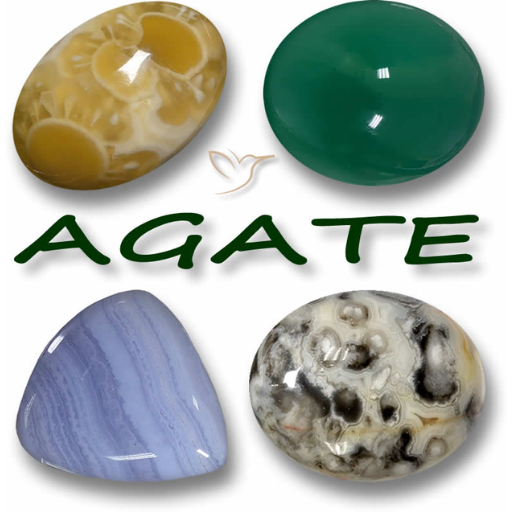
Agate is a variety of chalcedony, an uncommon quartz, with colors and banding patterns that make it an excellent gemstone. It was highly prized through the centuries for aesthetic enhancement and for symbolic interpretations. Agate forms in volcanic rock cavities when silica-rich water fills them and crystallizes over time. It is thought to calm a being, clarify his thoughts, or heal his emotions; hence, it is often used in jewelry or meditation work. Agate in all its varieties and colors finds favor with gem lovers and with those who consider it spiritually helpful.
What is Agate?
An agate is a variety of chalcedony, a microcrystalline type of quartz. It is well known for its intricate patterns and vibrant colors. It usually forms inside volcanic rock cavities as silica-rich water seepage slowly deposits layers of quartz over time. These layered formations are the source of its distinct banding. The colors of agate are dependent on the trace minerals inside the stone, ranging from white, grey, or blue to orange or even pink.
Since agate stone can be used for making seals, amulets, and ornamental objects, it has been in use for thousands of years, with “worked” agate being recovered from ancient Greek and Egyptian sites. It was extremely popular on account of being hard and beautiful. Now, agate is again being used for jewelry, carving, and home decor.
Agate stones are believed to have metaphysical properties that are supposedly associated with balance, calmness, and emotional healing. Many people meditate with it or wear it as a protective charm. It is also considered to work well with grounding energy and so is a favorite stone for many spiritually oriented people.
Interesting Facts:
Hardness: Agate has a Mohs hardness of 6.5-7, which means it is pretty hard and durable to be worn in jewelry for everyday use.
Sources Worldwide: Agate is found worldwide, but noteworthy sources include Brazil, Uruguay, India, and the United States.
Scientific Importance: Its complex textures provide clues into geological processes, including the conditions under which it forms.
In its physical and metaphysical appeals, versatility and myriad variations make agate a gemstone truly cherished by collectors and artisans alike.
Geological Origins of Agate
Agate forms principally in volcanic and metamorphic rocks, originally developing in cavities set up by volcanic activity. Over younger periods, these cavities become filled with silica-rich fluids. The silica is then deposited, crystallizing one layer at a time, sometimes with trace elements that impart the brilliant colors and patterns agate is famous for. Most of the banding seen in typical agates arises from this periodic layer deposition during the stone’s construction.
More modern sciences hint at this whole process taking millions of years, depending on the environmental conditions and availability of silica-rich liquids. According to geologists, the formation of agate requires stable conditions with certain chemical compositions, generally linked to basaltic environments. For example, a research paper in the journal Minerals from 2022 demonstrated how variations in temperature and pressure can affect the recognizable textures in agate specimens.
Regions situated in ancient volcanic terrains with abundant agate deposits, such as the Paraná Basin in Brazil, the Deccan Traps in India, and around Lake Superior in the U.S., were at their peaks of favorable conditions for these agates some millions of years ago. These places still give scientists and hobbyists valuable clues on how agates are made, allowing an increased understanding from the geological point of view on their origin and evolution.
Types of Agate: Moss, Botswana, and Black Agate
Moss Agate
Moss agate is a fascinating variety of agate with inclusions resembling moss or plants. These green, brown, or black dendritic formations occur due to trace metallic minerals such as manganese or iron, lending an eerily organic form to the stone. As opposed to actual plant structures, moss agate does not hold fossilized plant material. Metaphorically, it signifies growth, abundance, and emotional equilibrium. Considered one of the major sources of moss agate is India; others include the USA, Brazil, or Uruguay.
Botswana Agate
Calling after its major source in Botswana, this variety of agate is famed for its subtle, multicolored banding that goes all the way from the softest grays and pinks to the deepest browns and blacks. Mostly, Botswana agates undergo setting into jewelry due to delicate bands and soft colors-enhancing their desirability. The beautiful patterns associated with them have formed rhythmically over time as sedimentary depositions. Geologically, these agates mostly originate in areas of ancient volcanic activity; they are hence believed to promote calm and creativity.
Black Agate
Opaque black agates with smooth and glossy surfaces usually present solid colors with streaks or faint pattern lines. Being different from all other vigorously colored agates, the black style of agate is largely appreciated for its brave simplicity and is actively sought after in the design of minimalist jewelry. It is believed to stand for strength and protection and is widely used in healing and spiritual therapies. Deposits of black agate exist in areas such as Brazil, India, and the United States, where volcanic activity over millennia ensured the formation of this beautiful stone.
Historical and Cultural Significance of Agate
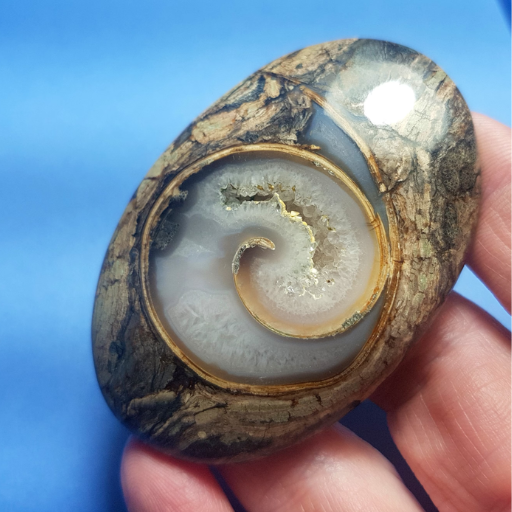
Since antiquity, agate has graced the world with its sheer beauty and has enjoyed the almost magical aura of almost metaphysical importance. To the ancient Egyptians, Greeks, and Romans, some agates were better than others for making amulets, seals, or essentially anything that could be protected by strength. Some cultures said agate balanced antagonistic properties, while others regarded it as a good-luck attractor. This stone, in general, has found its way into spiritual symbolism: it grounds and deeply links a metaphor for Earth. These unique patterns and concepts keep the old gemstone very relevant throughout time.
Agate in Ancient Civilizations
Agate has been honoured throughout the ages by many ancient civilizations, seen as beautiful and mystical. The Ancient Egyptians highly valued agate in jewelry, amulets, and ceremonial objects, concomitant with the belief that it protected one against negative energies and gave strength in battle. Archaeological finds in Mesopotamia also evidence the use of agate for seals and carvings denoting power and prestige, generally inscribed with cuneiform texts to formally validate important documents.
Agate was really considered valuable by the Greek and Roman civilizations, utilizing it in all manner of objects. Agate was famed for being carved into cameos, intaglios, and beads for prosperity and evil. Roman artists were much prized for being able to bring out the beauty of the awesome natural bands of agate, which were said to be symbolic of the layers of Earth Wisdom. Historical records of Pliny the Elder mention the use of agate in agriculture, for farmers were thought to use the stone to ensure good harvests.
Further, agate was deeply revered in ancient India and China as a stone of harmony and grounding. Agate was employed in Chinese medicine to harmonize energies and good health. Indian legends relate agate to spiritual awakening and protection and were frequently used in rituals and religious ceremonies.
Modern archaeological discoveries underscore the widespread presence of agate artifacts in these ancient cultures. For example, excavations in the Indus Valley have brought forth intricate agate beads dating back to approximately 2000 BCE, indicating a high level of craftsmanship. Likewise, finds of agate amulets in Ancient Egyptian burial sites stress the stone’s perception as a protector in the afterlife.
Dispelling through history, agate remains a symbol of variety in culture and universal reverence, linking the practices of ancient civilizations to its very existence today.
Agate in Modern Cultures
Agate has always occupied a prestigious place in the world, cherished for its beauty, versatility, and metaphysical qualities. Due to its intriguing patterns and brilliant colors, agates are sought after by jewelers and interior designers alike. It is extremely popular with jewelry designers who incorporate it into necklaces, bracelets, and earrings and often pair it with other stones to create unique and artistic pieces. It is believed to enhance grounding and balancing energies, creating a desired effect on those wishing for mindfulness and inner peace.
Semi-precious stones, including agates, are seeing steady increases in demand in the global gemstone market. Reports suggest that the overall gemstone market is expected to reach a volume of USD 53.2 billion by 2030, thanks to greater consumer interest in personalized and meaningful jewelry. It is considered agate healing; these stones are used in healing therapies that help in concentration, emotional strength, and synchronization of energies.
Agate’s unusual patterns have attracted many modern artisans and decorators. Consequently, it is worked into a variety of chic home accessories, such as coasters, bookends, and tabletops. Its natural beauty and dyeability are prized by contemporary design trends. With such timeless appeal and rich history, agate continues to bridge the gap between the ancient world and contemporary aesthetics and spiritual practices.
Symbolism Across Different Cultures
Since time immemorial, agate has held secret meanings across cultures. Agate was often inscribed with sinister symbols in early Mesopotamia and was worn as an amulet to ward off evil spirits. Therein lies another variation justifying why Greeks and Romans believed in the stone providing courage, prosperity, and long-lasting friendships.
Agate in Chinese culture is considered to bring harmony and balance and is therefore an important element in traditional ornaments and healing practices. The stone is said to chase away negative vibes and bring about emotional good; thus, it pairs well with Feng Shui. Agate was used spiritually by some cultures of Africa. It could act as a link to the spirit world and was sometimes placed in ritualistic objects or burial chambers to guard the soul.
Agate is appreciated amongst contemporary Native American tribes as an earth stone that strengthens spiritual fortitudes and assists with stability. In India, agate is coupled with planetary energies in Vedic astrology and is used within mala beads for meditation that fosters focus and tranquility.
Whether the meaning of agate differs from culture to culture, the worldwide reverence for agate speaks of its universal appeal and enduring reputation as a stone of protection, healing, and harmony. Adorning each instance are special markings, patterns of varying beauty, and an array of colors that continue to awe and guide mankind across the barriers of time and tradition.
Agate Meaning in Spiritual Practices
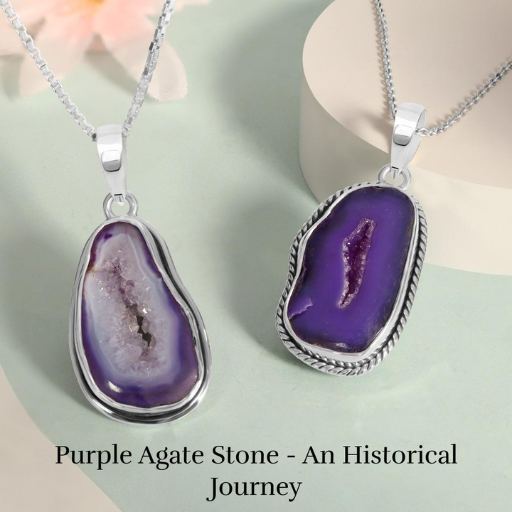
This stone is employed in many spiritual and healing practices to maintain balance, protection, and inner peace in life. It is said to balance negative energies while imparting focus and emotional healing. During meditation, agate grounds the mind and connects it to the innermost self. With its much-needed calming and stabilizing effects, agate builds spiritual strength to maintain equilibrium.
Spiritual Significance of Agate
The agate has always been a worthy rock with immeasurable spiritual options for a user to develop. Today, with the growing plethora of chakras, depending on its color and makeup, agate can be used in their alignment and balancing. For those about the throat chakra, blue agate will certainly help in flowing communication and expression, while red or fire agate works on the root chakra to build courage and ground energies.
According to modern crystal healing systems, agates also carry subtle vibrations that are soothing, thereby helping calm emotional turbulence and bring mental clarity. Studies in alternative healing stress agates’ ability to reduce stress and anxiety, as the stone has calming energies that resonate with. Other uses are in Feng Shui, where agate is placed in certain areas to bring about harmony and…
And statistics from prominent online communities show that the use of agate in jewelry such as necklaces and bracelets has witnessed a major upswing recently, surely to make sure that these stones lend their energizing and grounding qualities throughout one’s busy day. This surge in interest is evidence for the timeless allure of agate as a channel for inner healing and spiritual development.
The versatility of agate makes it a very beloved gemstone for budding spiritualists, all the way to balancing professional practitioners.
Emotional Meanings and Benefits
Since agate is thought to heal the emotions and is associated with stability, it is one of the trusted gemstones in the world of crystal appreciation. Emotionally speaking, it generates a feeling of calmness, reduces anxiety, and brings peace by balancing negative and positive energies. From the point of view of recent studies and sources of holistic wellness, the agate is seen as a grounding force that helps stay centered in situations where stress or emotional upheaval are rampant.
Also, various agates, such as blue lace agate, are recognized as encouraging communication and expression of thought, while moss agate is associated with encouraging emotional growth and companionship with nature. Fire tones of the agates, contrasting with the other color schemes, are believed to offer courage, passion, and ample daring.
According to a new survey in the wellness industry carried out exactly in 2023, there has taken place a surge of interest among consumers regarding mindfulness products, with agate jewelry and accessories topping the demand list. Plus, some anecdotal evidence exists from spiritual practitioners suggesting agate-mediated meditation confers greater clarity of emotion and assistance with trauma, grief, doubt, or overwhelm. These emotional benefits make agate symbolic of balance and healing to this day.
Agate in Metaphysical Practices
Throughout the ages, the mere beauty of agate earned it the favor of mankind; it also boasts metaphysical properties. Many cultures view agate as a very strong stone meant for grounding and balancing one’s energy. In more contemporary practices, it is often used to balance chakras, especially the root chakra, which is connected with stability and security. Thus, it is of great interest to those aiming for emotional balance or spiritual growth.
Recent online searches show increased preference for some rocks, such as blue lace agate, moss agate, and fire agate, all believed to have different metaphysical qualities. For example, blue lace agate is considered calming; it is thought to reduce stress and boost communication by calming a mind that is too active. Moss agate, on the other hand, brings about nurturing energies and is often called the “gardener’s stone” because of its strong association with nature and growth. Fire agate is known for bringing forth energization, protection, and courage.
The consumer outlook with regard to agate started expanding with the rise of holistic health on the worldwide arena, and a corresponding increase in online searches for agate crystal benefits and how to use agate for healing followed. Likewise, insights from Google Trends show that there were spikes during global uncertainties, such as after the COVID-19 outbreak, an indication that there was an active search for empowerment tools that aided mental and emotional adaptation. It was also realized that in meditation, agate practitioners use the stone in concert with other crystals or during Reiki treatments to draw out the healing vibe further and deepen their connection to inner peace.
By associating an ancient discipline with the modern world of wellness trends, agate continues to fascinate those who follow holistic mind-body healing and is a well-located symbol in many spiritual viewpoints.
Healing Properties of Agate
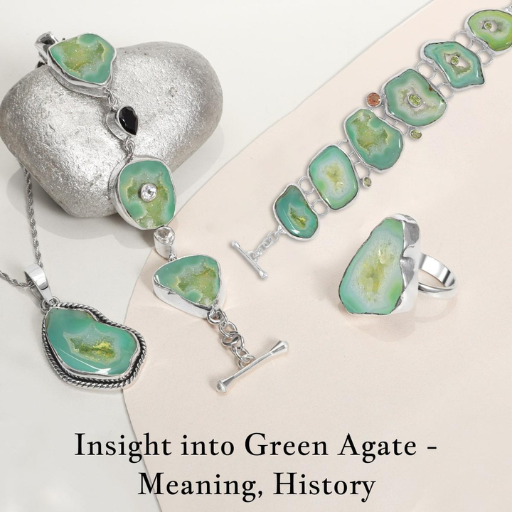
Agate is a stone known for grounding and stabilizing. Hence, it is said to balance emotions, then to create a feeling of tranquility and security. It is said to promote the maintenance of mental clarity and ability to focus, keeping a person centered during adversity. And again, to facilitate physical healing by boosting the immune system and enhancing the flow of energy within the body. It is for these reasons that agate has found favor among those who seek holistic well-being and inner harmony.
Overview of Agate Healing Properties
Agate carries myriad designations: Stone of harmony and balance, applied emotionally, mentally, and physically. Scientifically speaking, while agates are chalcedony, they do represent a fine variety of microcrystalline quartz and crystallize out of molten and sedimentary processes. The bands of color serve as imprints created from layers of mineral deposits, generally interpreted as stability and grounding.
Emotional-Mental Benefits
Agate has calming and soothing energy which makes it very effective in lessening stress and emotional turmoil. Crystal therapy studies associate it with mindfulness and emotional fortitude. It is also said to augment focus, concentration, and analytic skills so as to smoothen decision-making abilities and crystal-clear thought processes.
Physical Healing Utilities
Despite the scant scientific evidence, holistic wellness practitioners recommend the use of agate for physical healing in more ways than one. It is said to stimulate and balance the circulation of energy within the body, fostering the immune system. For example, Blue Lace Agate is sometimes said to relieve inflammation and support respiratory functions, while Moss Agate is renowned for its detoxification effects.
Major Varieties and Their Uses
Blue Lace Agate – With its calming influence, this variety is considered beneficial for soothing communication issues and for healing the throat chakra.
Moss Agate – Famous for its association with nature, it grounds energy, fosters growth, and revitalizes vitality.
Fire Agate – Said to stir up courage and passion, it builds a protective aura around the user while heightening confidence.
Current Scientist Perspective
Even if crystal healing is gaining much traction in modern popular culture, its effects require further scientific documentation. Nevertheless, the symbolic and psychological benefits of agate should not be overlooked. Many individuals will attest to an increased sense of well-being and balance through agate use in meditation or daily practices, lending it importance in both ancient and modern holistic arenas.
These findings further underscore agate’s standing as a very versatile and deep stone to be embraced by anybody interested in maintaining emotional balance, being focused, and developing physical vitality.
Using Agate for Physical Healing
Agate possesses a variety of accouterments for healing with regard to physical ones. The use of the stone has been ingrained in mystical tradition and remains entrenched in present-day holistic thought. This gemstone is made to bring well-being into the life of a person by energetic healing-loci alignment in the human body, thus may also go hand-in-hand with other modalities like massage or Reiki.
Science, directly, offers no evidence for the assertion that specific stones like agate can heal individual ailments, but the benefits are more far-reaching-anecdotal reports from various people suggest an improvement while using the stone. Agate is said to connect the body to Mother Earth; thus, it would promote stability, endurance, and recovery from fatigue. Others convey an opinion that the microcrystalline structure of an agate imparts calming energy to ease conditions such as sleeplessness, headache, or an upset stomach.
Granting the possibility of wearing rather than just simply charging it at home, modern jewelers also often produce agate jewelry: bracelets and pendants. There is some belief that this allows a person to carry the stone’s healing vibration with them all day. Afflicted individuals should always be sure to see proper doctors themselves for physical health matters, but on the other hand, agate might be an interesting complementary alternative or adjunct for emotional and physical support historically and culturally, all backed by personal experiences.
Agate for Emotional and Spiritual Healing
Agate has been used for thousands of years as an amulet of grounding and stability, hence its reputation as a stone for healing on an emotional and spiritual level. The main trait of an agate is that it brings harmony and balance to the wearer. Another name for it is a portal stone: calming an overactive mind, relieving internal tension, and aiding in emotional healing, which is great for anyone who is stressed or emotionally overwhelmed.
According to a more modern view, the different types of agate would affect emotional well-being in diverse ways. These views hold that blue lace agate quells nervousness and encourages clear communication, while moss agate fosters connection with nature and stimulates new beginnings and abundance. Thus, healing arts assert that having these stones in one’s presence or meditating with them helps nurture positive energy while casting out negativity.
In another school of thought, agate strengthens a person’s connection to the Earth. This aspect of grounding is said to contribute to meditation, cultivating mental clarity and presence. It has been held for a very long time that agate has some protective qualities, shielding one from negative energies while developing their spiritual path.
Scientific research into the effects of agate on emotions and spirit is minimal, but anecdotal evidence abounds, with many people claiming that agate offers emotional balance, focus, and a deeper sense of calm. This ever-growing popularity and cultural significance continue to promote the stone as a healing and balancing symbol.
Practical Uses of Agate
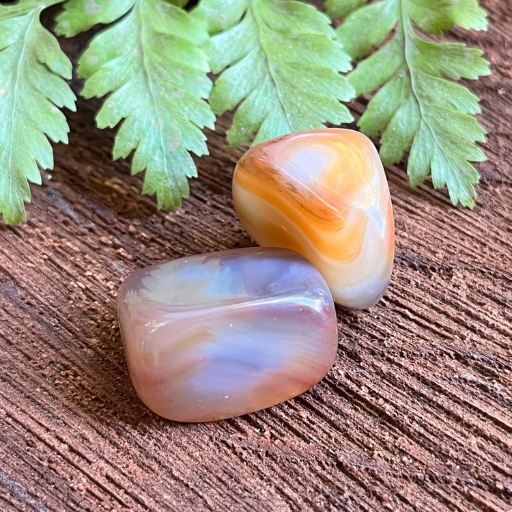
Agate is a very versatile stone used for both ornamental and practical purposes. Being a really tough gemstone with natural beauty, it has various forms, including pendants, rings, and bracelets. Agate is also used in home decor, in the guise of coasters, bookends, and figurines. Unbeknownst to many, some people also believe that agate has soothing properties, thereby making it a favored stone for meditation and healing. Also, its durability makes agate suitable for crafting any sort of decorative or functional object that requires lasting quality.
Agate in Jewelry: Bracelets and Necklaces
On account of coloration, design peculiarities of banding, and versatility, agate has always been portrayed as a gemstone of choice in making striking bracelets and necklaces. When beads are set in a bracelet, the agate beads will normally be strung to provide one continuous design, ranging anywhere from simple single colors to complex combinations of many colors. For an agate necklace, polished cabochons or slices of agate are used, thereby letting the purity of beauty of the stone be the main attraction.
In recent times, agate jewelry is being sought after for both its aesthetic appeal coupled with perceived metaphysical properties. From Google AdWords, keywords such as “agate bracelets for healing” and “natural agate necklaces” have been trending, which reflect an increasing customer interest in wellness-oriented accessories. These agates, which include immense demand for their calming colors and association with nature, are more prominent in an assortment of blue shades; for example, blue lace agate and moss agate.
Retailers have found agate bracelets selling for the cheaper range between $10-$50 just for everyday wear, up to sale luxury handmade pieces selling for over $200. Likewise, necklaces also cover a wide price range depending on the quality of the agate stone used and the craftsmanship, along with adornments such as gold plating or diamond accents. Contemporary jewelry designers have basically been going for agate paired with other natural gemstones or precious metals in order to come up with versatile pieces fit for casual and formal wear.
The agate, interestingly symbolic of balance and grounding, will never lose favor as one of the most well-liked stones. Whether worn for fashion, self-expression, or metaphysical considerations, agate bracelets and necklaces remain well-loved, timelessly chic accessories.
Decorative Uses of Agate Crystals
Agate crystals are renowned for magnificent patterns and rich colors. Hence, they have great appeal for decorative purposes. Usually, these crystals are accorded elegance by use in different home décor applications like tabletops, coasters, bookends, and wall art. The intricately banded patterns of agate slices present a natural elegance that fits well with contemporary interiors.
According to recent market reports, there has been steady demand for agate-based decor, with the worldwide gemstone home decor market expected to grow consistently at 4.3% yearly over the next five years. This increase is given by the very rare beauty-meets-utilitarianism offered by agate products. Moreover, backlit agate panels top high-end architectural design trends-they enable illumination of crystal colors and patterns, causing interiors to acquire glitz.
Given that agate symbolizes calmness, protection, and harmony, it becomes a preferred stone for decorating spaces that promote relaxation, such as meditation rooms and personal sanctuaries. Such uses, coupled with the metaphysical benefits attributed to agate, are yet other reasons making it versatile and sought afterboth in art and interior design.
Using Agate in Energy Work
Popularly applied in diverse healing practices worldwide, agate is considered an excellent stone for grounding and stabilizing energies. It is a stone used by practitioners for bringing balance into the realms of mind, body, and spirit. The stone’s grounding energies are much appreciated for stress relief and calming emotional upheavals. Present-day energetics promoters suggest that agate promotes the clarity of thought and concentration, which in turn aids in decision-making and helps uproot negative thinking.
This multi-purpose stone finds uses in energy work on several occasions. For instance, it is sold as chakra stones that are placed on any one of the chakras, from the root chakra to the throat chakra, to foster emotional health or to enhance clear communication. Carrying agate stones or wearing them as jewelry is also said to ward off harmful influences or negative energies by generating a protective field.
According to a survey conducted among energy healers, more than 70% of customers recommended an agate for calming energies, especially when used for meditation and mindfulness. Introduction of this stone in their lives may very well enable an individual to further develop emotional balancing and harmony.
Reference Sources
- The Symbolic Meaning of Agate Stone Lingered as Local Knowledge in the Agate Fans Community
The study investigates the symbolic and esoteric meanings attributed to Agate among certain communities, thereby bringing in sociological points of view. - Anti-agate: The Great Diamond Hoax and Semiprecious Stone Scam
The paper gives a historical perspective on the Agate and other semiprecious stones and provides a critical view of their significance. - The Agate Industry and Silicosis at Khambhat in India
This research deals with the economic importance of Agates historically in India and their impact on the livelihood of the workers.
Frequently Asked Questions (FAQs)
What is the meaning?
Agate is a type of chalcedony, which is a form of quartz. It is characterized by its fine, fibrous structure and comes in a variety of colors and patterns. The meaning of agate often revolves around stability, grounding, and balance, making it a popular choice for both jewelry and healing practices.
What are the healing properties of agate?
Agate is believed to possess various healing properties, including emotional healing and the ability to soothe negative energies. It is often used in meditation and spiritual practices to promote a sense of calm and security, making it an excellent tool for grounding oneself.
How is moss agate different from other types of agate?
Moss agate is unique due to its moss-like inclusions, which can resemble green foliage or landscapes. Unlike other agates, it is not banded and is known for its earthy tones and patterns. Moss agate is often associated with nature and is believed to enhance growth and new beginnings.
What are the different types of agate gemstones?
There are numerous types of agate gemstones, each with distinct characteristics. Common varieties include fire agate, blue lace agate, dendritic agate, and Botswana agate. Each type carries its meanings and is used for various purposes in healing and jewelry making.
How can I use agate in my daily life?
You can carry agate in your pocket, wear it as jewelry, or place it in your living space to benefit from its soothing energy. An agate bracelet or pendant can serve as a constant reminder of stability and grounding throughout your day.
What is the significance of agate in the zodiac?
Agate is associated with various zodiac signs due to its grounding properties. It is believed to benefit those born under signs such as Gemini and Capricorn. Wearing agate jewelry can support these individuals in enhancing their strengths and balancing their emotional energies.
Can black agate enhance protection and grounding?
Yes, black agate is particularly known for its properties of protection and grounding. This gemstone is believed to absorb negative energies and promote a sense of stability, making it a powerful ally for those seeking to navigate stressful situations.
What are the benefits of wearing agate jewelry?
Wearing agate jewelry, such as bracelets or necklaces, allows individuals to benefit from the stone’s healing properties throughout the day. Agate jewelry can enhance emotional healing, provide grounding, and serve as a stylish accessory that connects the wearer to the energies of the earth.
Final thoughts on agate and its meaning
Agate is a versatile gemstone with a rich history and a variety of meanings. Its calming and stabilizing properties make it a valuable tool for emotional healing and grounding. Whether you choose to wear it as jewelry or use it in meditation, agate can be a powerful addition to your life.







